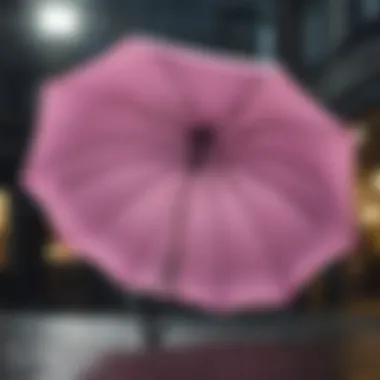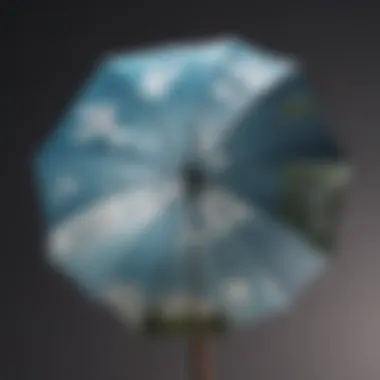Exploring the Inverted Umbrella: Cloud Nine Insights


Intro
The inverted umbrella stands out as a distinctive design innovation that draws attention for its unique functionality. This article seeks to unravel the layers of meaning embedded in its use, particularly through the lens of the metaphor "cloud nine." By exploring both the conceptual and practical dimensions of the inverted umbrella, we will delve into how it embodies ideas of comfort and emotional well-being. The interconnectedness of these themes can enrich our understanding of shelter, not only from the elements but also from life's challenges.
Background and Context
Overview of the Research Topic
Understanding the inverted umbrella requires a multifaceted approach. This object is not merely a tool for protection against rain; it acts as a symbol of broader concepts such as safety and emotional relief. Through its innovative design, the inverted umbrella has found applications in various cultural and geographical contexts, reflecting a shift in how we perceive personal space and shelter.
Historical Significance
Historically, umbrellas served primarily as protection against rain or sun. However, the emergence of the inverted umbrella design marked a departure from traditional functionality. This design was influenced by both practical needs and aesthetic preferences. Over time, the inverted umbrella has garnered cultural significance, resonating with ideas of resilience and adaptability. Moreover, its adoption in contemporary society evokes discussions about how design choices can reflect personal identities and emotional states.
Key Findings and Discussion
Major Results of the Study
The study reveals that the inverted umbrella is not just a functional item but also carries emotional weight. Several key findings emerged from our exploration:
- Design Innovations: The structure of the inverted umbrella allows for better water drainage, making it easier to use.
- Cultural Applications: In various cultures, it symbolizes protection and security, contributing to a sense of belonging.
- Emotional Well-being: By providing shelter, the inverted umbrella embodies concepts of comfort and safety in personal and communal spaces.
Detailed Analysis of Findings
The analysis of findings showcases the interplay between design and emotional significance. The inverted design enables users to enter and exit spaces without getting wet, minimizing inconvenience. This practical aspect is tied closely to enhancing user experience. Furthermore, the visual appeal of these umbrellas can evoke feelings of joy and optimism, linking them with the concept of "cloud nine."
The discussion highlights how the inverted umbrella can be seen as more than just a protective tool. It serves as a metaphorical shield against adversities, embodying the dual notions of security and happiness that are essential to the human experience.
"The inverted umbrella merges practicality with emotional symbolism, reflecting how design can influence our lives in unexpected ways."
As we proceed in this exploration, we will continue examining how cultural interpretations and individual experiences shape the understanding of the inverted umbrella and the emotional resonance of being on "cloud nine." This investigation not only deepens our appreciation for the object itself but also reflects ongoing societal values regarding comfort and security.
The Inverted Umbrella: An Overview
The inverted umbrella stands as a remarkable innovation in design and function, introducing unique principles of usability and comfort that hold a distinct place in both practical and symbolic contexts. This device not only addresses the mechanical necessity of keeping individuals dry but also reflects deeper emotional and social implications. The significance of exploring the inverted umbrella is rooted in its ability to bridge physical utility and abstract concepts such as security and emotional well-being. By examining its attributes, we can appreciate how this umbrella transcends its conventional role, hence becoming more than just a tool against rain.
Definition and Design
An inverted umbrella, unlike traditional umbrellas, opens in a manner that keeps the wet side contained within, preventing water from dripping onto the user. This design serves practical purposes, such as facilitating ease of entry and exit from confined spaces like vehicles or doorways. The mechanics of the inverted umbrella involve a unique folding mechanism that allows it to be turned inside out, creating a cone-shaped structure when closed. Through this innovative design, users experience convenience and utility that traditional umbrellas fail to provide. Its construction often utilizes lightweight yet durable materials, ensuring that it is both portable and resilient.
Historical Context
The concept of the umbrella has evolved significantly over centuries. Traditional structures originated in ancient civilizations such as Egypt and China, primarily serving as sunshades. The transition of functionality to protection against rain emerged much later, particularly in Europe during the 18th century. It is within this historical trajectory that the inverted umbrella finds its place. As innovations in design arose, including the inverted model, its utilization became more relevant in modern contexts, particularly with the rise of urbanization and changing weather patterns. The inverted umbrella emerged as a response to practical needs, addressing the inconveniences associated with traditional designs and symbolizing a shift towards greater adaptability in day-to-day life.
"The inverted umbrella represents a convergence of functionality and emotional symbolism, seamlessly integrating the practical with the conceptual."
As we engage with the layered meanings imbued within this object, it becomes evident that the inverted umbrella serves not merely as a tool but embodies the broader human desire for comfort and security amid the unpredictability of the elements.


Cloud Nine: A Conceptual Framework
The concept of Cloud Nine serves as an essential framework within this article, offering insights into the emotional and psychological layers that can be derived from the metaphor of an inverted umbrella. By examining the phrase and its origins, we begin to understand how the idea of being on "cloud nine" relates to feelings of bliss, comfort, and security, which can also be reflected in the functional design of the inverted umbrella. This relationship provides a rich context for exploring not just the physical object but also its symbolic representation in enhancing emotional well-being.
Among the specific elements that warrant attention are the psychological benefits associated with the imagery of "cloud nine." When individuals envision being on cloud nine, they often associate it with joy and peace. This positive mental state aligns well with the protective capabilities of an inverted umbrella, which offers shelter and comfort from external stressors such as the rain or storms of life. By analyzing these connections, we can gain a deeper appreciation for the ways in which physical objects influence our psychological states.
Moreover, considering the cultural implications of both terms—Cloud Nine and the inverted umbrella—adds another layer of depth. Different cultures may interpret the significance of comfort and protection in varied ways, illustrating how these concepts can influence broader social contexts. Understanding this interplay showcases the intricate dynamics between design, functionality, and emotional resonance, allowing us to appreciate the multifaceted nature of the inverted umbrella.
Origins of the Phrase
The phrase "cloud nine" has a rich etymology that dates back to various cultural references. It is often associated with a state of extreme happiness or euphoria. Linguistically, the earliest usages can be traced back to the 1950s, but precursors exist in different forms across various cultures. Some scholars suggest that it may have connections to the classification of clouds, where the tenth cloud was seen as the highest and therefore, the best. This ranking has facilitated a link between the concept of elevation—both physically and emotionally—and the feeling of elation.
Despite these origins, the appeal of cloud nine as an emotional reference continues to evolve. In contemporary language, it symbolizes a stark contrast to the tumultuous aspects of life. When paired with the idea of protection offered by an inverted umbrella, we can grasp a broader understanding of how individuals seek solace when confronted with adversity. Thus, the origins of the phrase allow us to delve into deeper inquiries about human experiences and their reflections in tangible objects.
Psychological Implications
Examining the psychological implications of being on cloud nine reveals significant insights into emotional health. Numerous studies indicate that feelings of happiness and comfort stem from factors like security, belonging, and the ability to manage stress. In this context, the inverted umbrella offers not just physical protection from the elements. It also becomes a metaphorical barrier against life's unpredictability and challenges, aligning closely with the euphoric state associated with cloud nine.
"Emotional well-being is often rooted in our ability to find comfort in our environment. The inverted umbrella can symbolize this desire for security, enhancing our perception of happiness."
Additionally, the concept draws attention to how personal experiences shape these feelings. Interaction with comfort-inducing objects, like an inverted umbrella, can trigger positive memories or associations, further reinforcing emotional resilience. This interplay between objects and mental states underscores the importance of design in enhancing psychological comfort. Overall, understanding these implications fosters a more profound recognition of how everyday items can influence our emotional landscapes, thus bridging the gap between the metaphorical and the practical.
Functional Aspects of the Inverted Umbrella
The functional aspects of the inverted umbrella provide significant insights into its design and usability. Understanding these elements is crucial when analyzing both its practicality and its emotional associations as discussed in the metaphor of cloud nine. Inverted umbrellas offer unique benefits, addressing common issues faced by users of traditional umbrellas while also embodying deeper meanings related to comfort and security.
Mechanics of Operation
The operation of an inverted umbrella diverges from that of a standard umbrella. During the closing process, the inverted design turns inside out, allowing water to be contained within rather than dripping onto the user. This mechanism relies on a modified structure where the ribs and fabric are aligned inversely. Such functionality is advantageous for quick entry into vehicles or buildings, particularly in rainy weather.
The key benefits include:
- Reduced Water Spillage: As the water remains inside, users can avoid creating puddles when closing the umbrella.
- Wind Resistance: The unique design is often more aerodynamic, which makes it less likely to flip inside out in strong winds.
- Ease of Use: Users can operate the umbrella with a simple mechanism, usually a push-button, allowing for greater convenience.
Materials Used in Construction
The construction of inverted umbrellas utilizes modern materials to enhance durability and function. The choice of materials plays a pivotal role in ensuring the longevity and usability of the product. Common materials include:
- Ripstop Nylon or Polyester: These fabrics provide excellent waterproof qualities while remaining lightweight. They resist tearing and add to the overall strength of the umbrella.
- Fiberglass Ribs: Unlike traditional metal frames, fiberglass ribs offer flexibility and strength, making the umbrella more resilient in windy conditions.
- Rubberized Grip Handle: This design improves comfort during use while maintaining a secure grip, even in wet conditions.
Understanding the mechanics and materials involved in the inverted umbrella illustrates its evolving role not just as a functional object but also as a symbol of emotional protection and stability. Through their design, inverted umbrellas align with the notion of shelter, further emphasizing the contentment associated with the metaphor of cloud nine.
"An inverted umbrella not only protects from rain but also signifies a deeper sense of emotional refuges, akin to the state of being on cloud nine."
This exploration serves to reinforce the idea that practical objects can embody significant emotional value, resonating with our need for comfort in daily life.
Comparative Analysis of Umbrella Designs
The analysis of umbrella designs is crucial in understanding the practical and symbolic dimensions of modern umbrellas, particularly the inverted umbrella. This section will detail the functional characteristics and distinctions between traditional and inverted umbrella designs, as well as highlight recent innovations that enhance their usability and appeal. By examining these elements, readers can gain insight into how design influences both market trends and consumer behaviors.


Traditional vs. Inverted Umbrellas
Traditional umbrellas have been a staple for protection against rain and sun for centuries. They typically open from the bottom, with the canopy facing up, which can lead to the accumulation of water. This design poses challenges like dripping water on the user upon closing and difficulty in handling winds, which can sometimes turn the umbrella inside out.
In contrast, inverted umbrellas, as the name suggests, open in reverse. The canopy flips inside out when closed, catching rainwater inside the structure. This unique feature mitigates the problem of water dripping on the user. The structural design allows for easier storage, as the wet side is contained within the umbrella, keeping users and surrounding areas dry. Moreover, the ergonomic handle design enables users to open the umbrella with one hand, a functionality highly appreciated in busy scenarios.
- Key differences include:
- Water collection: Inverted umbrellas contain water, while traditional umbrellas let it drip.
- Wind resistance: The inverted design provides more stability against gusty winds.
- Usability: One-handed operation is generally easier with inverted models.
Innovations and Improvements
Recent years have seen significant developments in the design of both traditional and inverted umbrellas. Manufacturers have integrated advanced materials and technology to enhance usability. For instance, wind-resistant frames made from fiberglass offer durability without adding weight. Additionally, automatic opening and closing mechanisms have simplified the user experience.
Comparatively, inverted umbrellas have witnessed unique innovations. Some models now feature double-layered canopies, allowing for improved ventilation and reduced wind resistance. Others incorporate UV protection and enhanced durability, making them suitable for various weather conditions.
- Notable innovations in umbrella design:
- Fiberglass frames: Lighter and more durable than traditional materials.
- Automatic mechanisms: Facilitates quick and effortless use.
- Double-layered canopies: Enhances stability and airflow.
Cultural Significance of Umbrellas
The cultural significance of umbrellas extends far beyond their practical use for shelter against rain or sun. In this article, the exploration of the inverted umbrella connects deeply with various cultural meanings and symbols around the globe. Recognizing these associations enhances our understanding of design intentions and consumer appeal. The cultural relevance of umbrellas reveals how they serve as conduits for expression, identity, and emotional resilience.
Symbolism in Different Cultures
Umbrellas symbolize a range of concepts across multiple cultures. In some places, they denote honor and status. In many Asian cultures, the umbrella is a symbol of protection and is often associated with royalty. For instance, in traditional Asian art and ceremonies, the size and color of an umbrella can reflect the rank of the individual bearing it. This practice illustrates the inverted umbrella concept, where protection can also suggest a keen sense of responsibility toward community well-being.
In other cultures, umbrellas serve as metaphors for security and comfort, similar to the way Cloud Nine connects to emotional well-being. In literature and storytelling, umbrellas are often depicted as havens, where characters find solace amid chaos. This practice allows for deeper discussions on how physical objects can shelter not just the body, but also the spirit.
The Umbrella in Art and Literature
Umbrellas have long held a prominent place in art and literature. Artists and authors have utilized them to convey complex emotions and themes. For example, they can signify protection, loneliness, or even the duality of human existence. In many paintings, such as those by Claude Monet, umbrellas become focal points that encapsulate the connection between nature and human emotion.
In literature, umbrellas often represent the fragility of human experiences. In works like "The Umbrella Man" by Roald Dahl, the symbolism of the umbrella serves to comment on deceit and vulnerability. These narratives invite readers to consider how ordinary objects can embody deeper meanings and resonate with personal experiences.
The meta-narrative of the umbrella challenges readers to reflect on their own perceptions of comfort and security in a fast-paced and uncertain world.
Overall, the cultural significance of umbrellas, especially the inverted umbrella, transcends its physical form. By examining this significance through various lenses, we can appreciate the broader implications of shelter, protection, and support in human life.
Emotional Comfort and the Inverted Umbrella
The inverted umbrella serves not only a practical purpose but also provides significant emotional comfort. This section examines how the design and symbolism of the inverted umbrella align with the desire for security in various life circumstances. The correlation between physical shelter and emotional well-being is profound, and understanding this relationship can enhance our appreciation of this object.
Shelter from the Storms of Life
Life presents a series of challenges, often likened to storms that can feel overwhelming. The inverted umbrella represents a physical embodiment of refuge during such times. Its design allows individuals to use it as a shield against literal inclement weather, but the concept extends far beyond that. The inverted umbrella can be seen as a metaphor for seeking protection from emotional turmoil. It offers a tangible sense of control amid chaos. By providing real shelter during a storm, one can also foster mental resilience.


From a psychological perspective, the feeling of being sheltered contributes positively to emotional health. A secure environment allows individuals to process their feelings of anxiety or distress without further exposure to external pressure. The act of using an inverted umbrella during rain, serves as a reminder that one is prepared for challenges. This preparedness can lead to a greater sense of personal agency.
Symbol of Protection and Security
When we consider objects that symbolize protection, the inverted umbrella stands out notably. Unlike traditional umbrellas that shelter us from falling rain, the inverted umbrella also embraces an idea of inner security. Its flipped design allows one to gather rainwater, symbolizing the capacity to absorb negative experiences and transform them into something useful. This transformation of adversity into resilience is both empowering and encouraging.
The emotional state associated with protection is critical. When individuals perceive that they have a means of safeguarding themselves, they often feel a heightened sense of confidence. The inverted umbrella can thus signify not only physical protection but also emotional strength. It serves as a reminder that even in challenging situations, there exists the possibility of nurturing one's emotional landscape.
"The inverted umbrella may be more than just a tool for rain; it embodies the human quest for refuge and emotional balance in life’s unpredictable journey."
For further reading about the significance of symbols in different cultures, consider visiting Wikipedia.
Market Trends and Consumer Behavior
Understanding market trends and consumer behavior regarding inverted umbrellas is vital for identifying how this innovative item fits into contemporary lifestyle choices. With the rising emphasis on multifunctionality in home and personal items, the inverted umbrella presents not just practicality but a blend of design and emotional significance. This section explores why these trends are not just popular; they reflect evolving consumer expectations.
Popularity of Inverted Umbrellas
The popularity of inverted umbrellas has seen a notable rise in recent years. Several factors contribute to this trend:
- Functionality: Designed to close in a way that traps water inside, inverted umbrellas offer convenience. Users can avoid wet floors when entering buildings, a common issue with traditional designs.
- Aesthetic Appeal: Many consumers are drawn to the modern look of inverted umbrellas. Sleek designs and various patterns meet both functional needs and a desire for fashionable accessories.
- Social Media Influence: Platforms like Instagram and Facebook have played a significant role in promoting unique products. The visually appealing aspects of inverted umbrellas make them more shareable, prompting wider acceptance.
"The design and convenience factors intertwine effectively, making inverted umbrellas a favorite among consumers."
Sales data show that manufacturers have adjusted production to focus on inverted models, indicating a robust market opportunity. Consumers seem willing to invest more in items that offer not only protection but also an expression of personal style and innovation.
Target Demographics
Identifying the target demographics is crucial for understanding the market for inverted umbrellas. Different groups show distinct preferences and priorities:
- Young Adults: Often aged 18-35, this demographic values style alongside functionality. They appreciate the novelty of inverted umbrellas, often favoring them for their unique look and practical use.
- Parents with Young Children: For this group, the inverted umbrella’s ability to prevent water dripping indoors is appealing. It reduces mess, making it practical for family outings.
- Professionals: Those working in urban environments often seek reliable and stylish solutions for unpredictable weather. Inverted umbrellas meet this need well, enabling compact carrying while providing adequate coverage.
- Elderly Consumers: The ease of use associated with inverted umbrellas makes them accessible. Features like automatic open-and-close mechanisms are advantageous for older adults.
By understanding the nuances within these demographics, manufacturers and retailers can tailor their marketing strategies to meet specific consumer demands effectively. This informs decisions on design, pricing, and promotional tactics, ensuring a relevant and competitive product offering.
The End: Fusing Function with Symbolism
The exploration of the inverted umbrella uniquely intertwines its functional capabilities with deeper cultural and emotional significances. In this context, the inverted umbrella stands not only as a practical item designed to offer shelter but also serves as a rich symbol of comfort, security, and emotional well-being.
Reflection on the Inverted Umbrella
Reflecting on the inverted umbrella's design reveals layers of complexity that surpass its basic utility. The inverted mechanism, which allows the umbrella to close inward rather than outward, embodies resilience against adverse weather. This physical characteristic resonates metaphorically with the challenges of life. When faced with storms—literal or figurative—the inverted umbrella reminds users that there exists a space of refuge. This duality offers an opportunity for deeper reflection on how we perceive protection and vulnerability.
Moreover, the act of opening an inverted umbrella may be seen as a deliberate choice to embrace one’s circumstances, inviting the rain rather than shying away. This can inspire a sense of agency in the user—an acknowledgment of the unpredictable nature of life while equipping them with the means to navigate it.
Future Perspectives
Looking to the future, the potential of inverted umbrellas in various sectors warrants attention. As urban areas become increasingly crowded, the need for multifunctional and space-efficient designs intensifies. The inverted umbrella not only provides rain protection but could also be adapted for urban environments in innovative ways, such as integrating technology for weather monitoring or providing additional features like solar panels.
The continuing advancement in materials science can lead to even lighter, stronger, and more adaptable umbrellas that will serve diverse functions while maintaining aesthetic appeal. As society grows more conscious of mental health and emotional resilience, the inverted umbrella may further solidify its place not merely as a protective tool but also as a cultural artifact signifying safety amidst chaos.
Ultimately, the future of the inverted umbrella may pivot towards a convergence of its practical benefits and its symbolic role in providing comfort and fostering a sense of security. Understanding this duality is not just for manufacturers, but offers insights for educators, students, and society at large—encouraging everyone to reflect on how objects shape our experiences and contribute to our well-being.
"In every storm, we find the strength to shelter ourselves, reminding us that even the simplest objects can carry profound meaning."
The inverted umbrella's journey from mere object to a symbol of resilience demonstrates the interplay between design, functionality, and the emotional landscapes we navigate. In grasping this concept, we extend our appreciation for such items beyond their physical form, elevating them as vessels of shared human experience.







